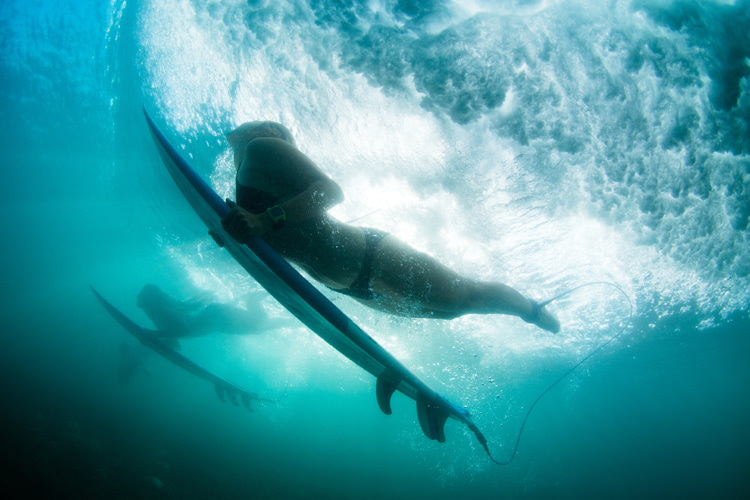There are a lot of things that can discourage a developing surfer: mistiming their pop-ups, the lack of fluidity in their turns and twists, not being able to tap into the wave's energy, and so on.
As a result, youngsters who pick up surfboards with dreams of making cool moves like duck dives might quit even before they start practicing them.
That being said, duck diving, in particular, can just be discouraging for a surfer who's been dreaming big.
There are a couple of reasons for that.
First of all, it's a crucial aspect of advanced surfing, so if you fail, it's natural to start worrying about whether your abilities are adequate.
Secondly, it's a move that requires you to go underwater beneath turbulent foam with your board.
If you don't get it right, there is little chance that you'll enjoy it.
Lastly, and most importantly, it takes lots of practice, even for pros, so just the sheer effort you'd put into practice might put you off.
Luckily, you have Clayton Nienaber and OMBE Surf at your disposal, and we're going to tell you how you can improve your duck dive in four simple steps in this tutorial.
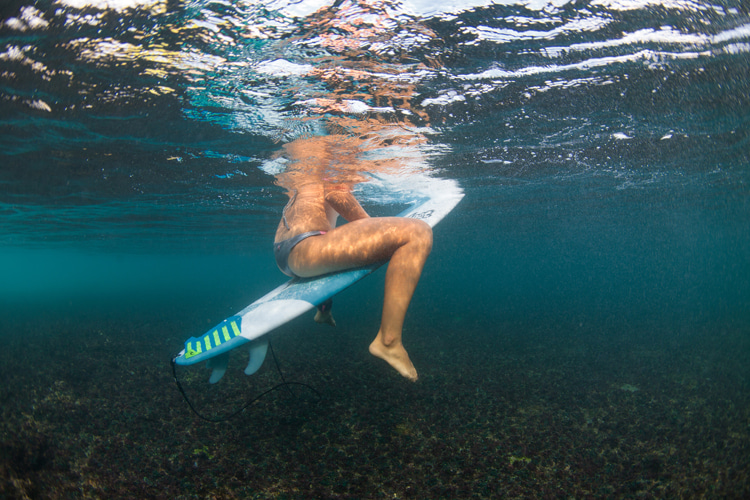
Step 1: Moving Forces
There are two basic moving forces: your momentum and the force of water.
This point extends past duck diving into every other aspect of surfing.
People tend to overestimate their momentum and underestimate the force of the ocean, but for a good duck dive, understanding both equally is rather important.
Momentum
One of the main elements you need to build before a duck dive is speed. For that, you need to paddle up to the wave.
However, you always take a risk whenever you build speed: the risk of losing control.
If you lose control of your board while paddling, you'll start wobbling in the wave and eventually fall over.
So, keeping the board in a straight line while pushing it through the wave is crucial for a good start.
A common mistake those who just started their duck diving exercises make is that they stop paddling once they see the wave approach.
If you're new to it, it's understandable that you'd be afraid when faced with such a sight and either panic and start wobbling or flee the scene.
In such situations, flight or freeze really doesn't work (and I don't know whether there is any scenario in which these two produce any tangible results).
What you have to do is preserve your momentum and dive straight into the wave.
The Intrinsic Forces of the Wave
For those who are new to surfing and those who haven't yet developed an intrinsic understanding of the ocean, the wave only consists of its crest.
That's also quite understandable since the crest is the part of the wave that draws the most attention when you're looking at it from the shore or watching it on your TV.
But, when you spend enough time in the ocean, you become aware that there are other forces present in a wave as well.
In that sense, especially the forces at the bottom of the wave are more important than what's going on at the crest.
The Forces at the Bottom of the Wave
A wave pulls water from the bottom, builds it up, and throws it from the top.
It means that the source of the wave's energy is actually at its bottom, and that's where the forces you need to be aware of are.
These forces at the bottom are also responsible for producing wave breaks.
If you watch a wave from under the water, you'll realize how these forces work, and you'll see that there is a cylindrical white foam beneath the wave when it breaks.
This type of break creates lots of turbulence, which ends up with the foam being pulled up to the top of the wave.
The trick of duck diving is going underneath all that turbulence and coming out through the back of it so that you can make your way to the top once it's up.
There is a little nuance for different types of foam, too.
If the foam is like a huge and chaotic white ball, you have to wait until the turbulence settles; otherwise, you won't know what's going on.
So, you need to take longer to surface.
In flat foams, though, you only need to dive underneath and let the energy at the back pull you back to the surface as if it wants to eject you.
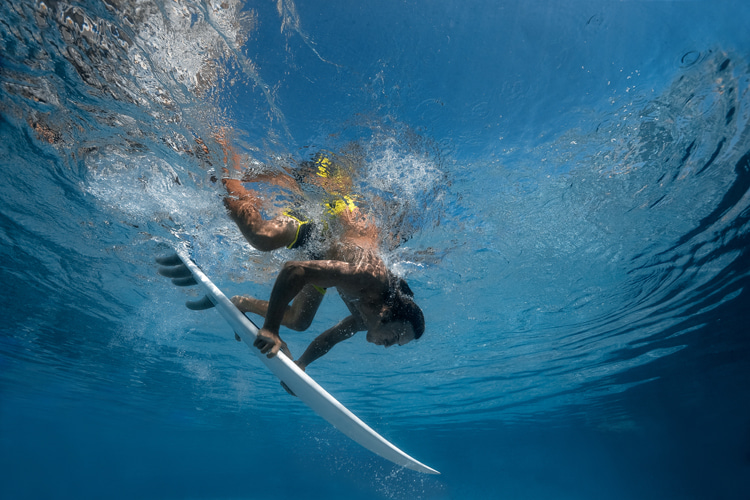
Step 2: Timing
Of course, talking about white foam underneath a wave when you're not on your board is easy.
When you're out there paddling, though, identifying it and timing your dive accordingly might be a bit more testing.
Therefore, knowing when you need to push the nose of your board down is another crucial aspect of duck diving.
The turbulence of white foam is like an explosion, more specifically, an explosion that follows the wave break.
And, just like an explosion, it sends little waves of turbulence of its own along the way, just beneath the surface.
It means that if you dive before you're close to the lip of the wave, you'll catch some of that turbulence and possibly start wobbling.
The trick is waiting for the lip of the wave to close in while you're paddling toward it and timing your dive in a way that puts you right beneath the foam with the least exposure to turbulence possible.
In other words, you need to dive into the power zone of the wave, where it draws water from the bottom.
That way, you'll be able to escape the explosive energy of the foam beneath and tap directly into the energy at the back that sucks you back up to the surface.
If you dive too early due to either fear or anxiety, though, you'd be part of that nasty explosion and would have to fight your way above.
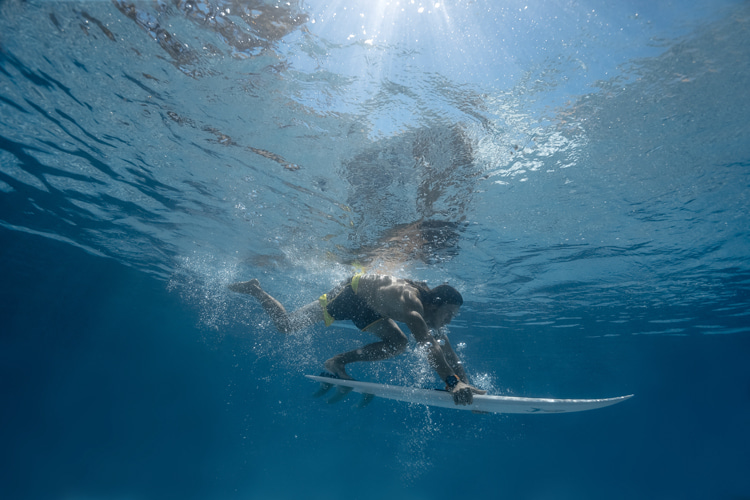
Step 3: Rhythm (or Flow State)
To an extent, surfing is simply listening to the wave and adjusting your body and board accordingly.
It's like keeping in rhythm with the wave and adapting to its state of flow.
Duck diving is no exception to this rule; on the contrary, it's one of the moves where you can observe it more clearly.
Let's say that you just dived in for the first time and didn't heed the wave's energy.
The possible outcome will be the wave immediately pushing you back up before you can even see the foam.
And since you'll still be in front of the wave, you won't progress at all.
If you pay attention to what the wave is doing, though, you'll be able to identify its rhythm with enough practice.
You'll know that you have to push your board down and extend it in order not to get sucked up by the energy close to the surface.
Also, once the wave passes over you, you'll know when to release your downward pressure on the board so that you can be drawn toward the surface.
That's how you go through and channel that energy (or even "missile" it, as Clayton says in our tutorial video below).
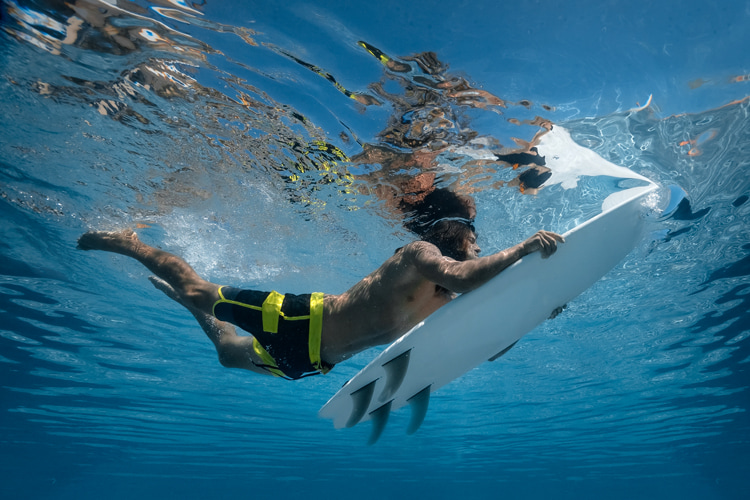
Step 4: Resurfacing
Unsurprisingly, our final step is resurfacing, and for resurfacing, the most important element is stability.
There are lots of forces left in the aftermath of a wave break.
Some of the water moves forward, and some of it flows backward, which might cause you to wobble once you lose concentration.
You need to activate your core muscles to prevent your body from wobbling due to all that energy, and you need to keep control of the board by extending it.
You can imagine it as if you're trying to come out of a pool by pushing off on its wall.
As long as you keep a straight line and maintain stability, you'll just glide out.
Common Duck Diving Mistakes
Diving perfectly is quite difficult by itself.
When you add a big wave coming toward you into the equation, it gets a bit scarier, too. Newbies to duck diving will naturally make lots of mistakes.
Some of these are quite simple:
Freezing
When the wave is closing in, some surfers stop paddling in fear, and they lose their momentum, which is a prerequisite for a good dive.
Diving Too Early
If you dive too early, you're likely to be caught in the preceding turbulence of white foam. You need to get to the part of the wave where the water is drawn up from the bottom.
Not Pushing the Back of the Board
People learn to push the front of the board more quickly than the back.
But your board needs to be level once you are beneath the wave, so you need to push the tail as well.
If you stick your hips out and leave the tail in the air, there's a good chance that the foam will catch you.
There are also some other mistakes that have more complicated consequences.
Let's check them out in a bit more detail.
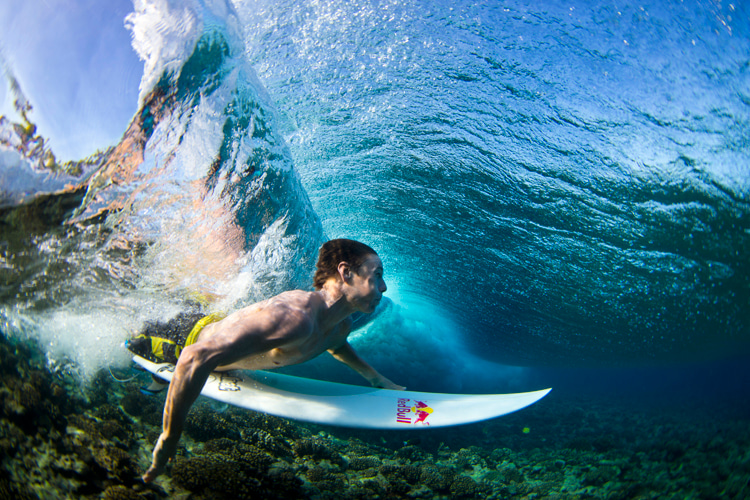
Ditching the Board
You might have come across some rookie surfers ditching their boards.
That's mostly because they lack self-confidence or the necessary skills to ride the wave that's approaching (or they might have seen a shark, which is completely another matter).
However, a surfer should never ditch their board, just like a captain should never ditch their boat, but it's not a matter of honor at all.
Some of these boards are quite big.
They have considerable strike radiuses, and there are probably lots of other surfers around you.
When you ditch your board, you risk injuring them.
It all depends on the waves' direction and strength, but the people right behind you are especially susceptible to injuries when you leave your board to the mercy of the ocean.
Furthermore, when you're practicing your duck dives, you should be on the lookout for who's in front of you and how confident or skilled they seem on their board.
The moral of this story is that no one wants to paddle behind a rookie surfer who might ditch their board at any time.
Getting Caught in the Turbulence
You might dive too early or too shallowly and end up in turbulence.
If that happens, the force of the turbulence will push you back to where you came from or wash you over.
Being pushed back means you failed, but it's not as unpleasant a failure as being washed over by it.
There is a lot of water movement in that turbulence, and if you try to maintain your path, the outcome will likely be hectic struggles and growing anxiety.
To prevent that and potentially more serious follow-up, you just need to turn sideways.
That will pop you up to the top. Once the energy of the wave dissipates, you can paddle back to the shore or try again.
Pushing With the Knee vs. Pushing With the Foot
Some surfers use their knees to push their board below the surface, and some use their feet, but it's not necessarily about style.
When a rookie sees a pro doing a knee push, they might consider it the correct technique, but it's not about a single proper technique, either.
Whether you push your board with your knees or feet depends on the strength of the wave.
If the wave you're going to duck dive into is powerful, it's better to push the board deep with your back foot.
Since you'll be applying more force that way, you'll be diving deeper.
If the wave is not particularly strong, you don't need to dive too deep.
So, a knee push will suffice to put you underneath the foam and resurface.
Not diving too deep will help you conserve energy as well.
Wrapping Up: How to Do a Proper Duck Dive
Now that you know all the little nuances and big mistakes about duck diving, we can concisely put everything in the right order and wrap our tutorial up:
- Towards the end of your paddling and right before your dive, get a couple of strong strokes in a straight line. That way, you'll be building momentum, and when you push your board into the water, it'll have more stability;
- Extend your arms and let the board submerge into the water;
- Push the tail of the board either with your knee or back foot, depending on the strength and energy of the wave;
- Stay clear of the turbulent white foam right above you by leveling your board and bringing your head down on it. It will lessen your head, and you'll easily glide past the wave;
- Resurface as stable as possible as if you're coming out of a pool by pushing off its walls;
Words by Clayton Nienaber | OMBE Surf | www.ombe.co
